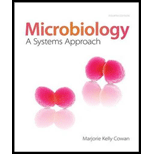
Microbiology: A Systems Approach
4th Edition
ISBN: 9780073402437
Author: Marjorie Kelly Cowan Professor
Publisher: McGraw-Hill Education
expand_more
expand_more
format_list_bulleted
Concept explainers
Question
Chapter 3.2, Problem 8AYP
Summary Introduction
To differentiate:
The principles of light microscopy and electron microscopy.
Concept introduction:
The microscopes require a source of light to clearly visualize the image. On the basis of the light source, the microscopes are of two types, light microscopes and electron microscopes. Both types of microscopes produce a clear image of the image with some differences occurred due to the phase of the light.
Expert Solution & Answer
Want to see the full answer?
Check out a sample textbook solution
Students have asked these similar questions
Please draw in the missing answer, thank you
Please fill in all blank questions, Thank you
please fill in missing parts , thank you
Chapter 3 Solutions
Microbiology: A Systems Approach
Ch. 3.1 - Prob. 2CFCh. 3.1 - Explain what the Five Is mean and what each step...Ch. 3.1 - Discuss three physical states of media and when...Ch. 3.1 - Compare and contrast selective and differential...Ch. 3.1 - Provide brief definitions for defined and complex...Ch. 3.2 - Prob. 5AYPCh. 3.2 - Prob. 6AYPCh. 3.2 - Prob. 7AYPCh. 3.2 - Prob. 8AYPCh. 3.2 - Compare and contrast the three main categories of...
Ch. 3 - Prob. 1CFCh. 3 - Prob. 1MCQCh. 3 - A mixed culture is a. the same as a contaminated...Ch. 3 - Resolution is ____ with a longer wavelength of...Ch. 3 - A real image is produced by the a. ocular. b....Ch. 3 - Prob. 5MCQCh. 3 - The specimen for an electron microscope is always...Ch. 3 - Prob. 7MCQCh. 3 - Bacteria tend to stain more readily with cationic...Ch. 3 - Multiple Matching. For each type of medium, select...Ch. 3 - A fastidious organism must be grown on what type...Ch. 3 - Agar has the disadvantage of being easily...Ch. 3 - A subculture is a culture made from an isolated...Ch. 3 - Prob. 13TFCh. 3 - Prob. 14TFCh. 3 - The best stain to use to visualize a microorganism...Ch. 3 - Prob. 1CTQCh. 3 - Prob. 2CTQCh. 3 - Prob. 3CTQCh. 3 - What is the functional type of mannitol salt agar...Ch. 3 - Create a short paragraph to differentiate among...Ch. 3 - Prob. 6CTQCh. 3 - Prob. 7CTQCh. 3 - a.Create a paragraph to differentiate among the...Ch. 3 - Prob. 9CTQCh. 3 - You are a scientist studying a marsh area...Ch. 3 - Prob. 1CCCh. 3 - Prob. 2CCCh. 3 - Prob. 3CCCh. 3 - Prob. 4CCCh. 3 - Prob. 5CCCh. 3 - Visual Connections Blooms Level 5: Evaluate These...Ch. 3 - Prob. 1CM
Knowledge Booster
Learn more about
Need a deep-dive on the concept behind this application? Look no further. Learn more about this topic, biology and related others by exploring similar questions and additional content below.Similar questions
- please draw in the answers, thank youarrow_forwarda. On this first grid, assume that the DNA and RNA templates are read left to right. DNA DNA mRNA codon tRNA anticodon polypeptide _strand strand C с A T G A U G C A TRP b. Now do this AGAIN assuming that the DNA and RNA templates are read right to left. DNA DNA strand strand C mRNA codon tRNA anticodon polypeptide 0 A T G A U G с A TRParrow_forwardplease answer all question below with the following answer choice, thank you!arrow_forward
- please draw in the answeres, thank youarrow_forwardA) What is being shown here?B) What is indicated by the RED arrow?C) What is indicated by the BLUE arrow?arrow_forwardPlease identify the curve shown below. What does this curve represent? Please identify A, B, C, D, and E (the orange oval). What is occurring in these regions?arrow_forward
- Please identify the test shown here. 1) What is the test? 2) What does the test indicate? How is it performed? What is CX? 3) Why might the test be performed in a clinical setting? GEN CZ CX CPZ PTZ CACarrow_forwardDetermine how much ATP would a cell produce when using fermentation of a 50 mM glucose solution?arrow_forwardDetermine how much ATP would a cell produce when using aerobic respiration of a 7 mM glucose solution?arrow_forward
- Determine how much ATP would a cell produce when using aerobic respiration to degrade one small protein molecule into 12 molecules of malic acid, how many ATP would that cell make? Malic acid is an intermediate in the Krebs cycle. Assume there is no other carbon source and no acetyl-CoA.arrow_forwardIdentify each of the major endocrine glandsarrow_forwardCome up with a few questions and answers for umbrella species, keystone species, redunant species, and aquatic keystone speciesarrow_forward
arrow_back_ios
SEE MORE QUESTIONS
arrow_forward_ios
Recommended textbooks for you
 Biology (MindTap Course List)BiologyISBN:9781337392938Author:Eldra Solomon, Charles Martin, Diana W. Martin, Linda R. BergPublisher:Cengage Learning
Biology (MindTap Course List)BiologyISBN:9781337392938Author:Eldra Solomon, Charles Martin, Diana W. Martin, Linda R. BergPublisher:Cengage Learning Principles Of Radiographic Imaging: An Art And A ...Health & NutritionISBN:9781337711067Author:Richard R. Carlton, Arlene M. Adler, Vesna BalacPublisher:Cengage Learning
Principles Of Radiographic Imaging: An Art And A ...Health & NutritionISBN:9781337711067Author:Richard R. Carlton, Arlene M. Adler, Vesna BalacPublisher:Cengage Learning Concepts of BiologyBiologyISBN:9781938168116Author:Samantha Fowler, Rebecca Roush, James WisePublisher:OpenStax CollegeSurgical Tech For Surgical Tech Pos CareHealth & NutritionISBN:9781337648868Author:AssociationPublisher:Cengage
Concepts of BiologyBiologyISBN:9781938168116Author:Samantha Fowler, Rebecca Roush, James WisePublisher:OpenStax CollegeSurgical Tech For Surgical Tech Pos CareHealth & NutritionISBN:9781337648868Author:AssociationPublisher:Cengage



Biology (MindTap Course List)
Biology
ISBN:9781337392938
Author:Eldra Solomon, Charles Martin, Diana W. Martin, Linda R. Berg
Publisher:Cengage Learning

Principles Of Radiographic Imaging: An Art And A ...
Health & Nutrition
ISBN:9781337711067
Author:Richard R. Carlton, Arlene M. Adler, Vesna Balac
Publisher:Cengage Learning

Concepts of Biology
Biology
ISBN:9781938168116
Author:Samantha Fowler, Rebecca Roush, James Wise
Publisher:OpenStax College

Surgical Tech For Surgical Tech Pos Care
Health & Nutrition
ISBN:9781337648868
Author:Association
Publisher:Cengage